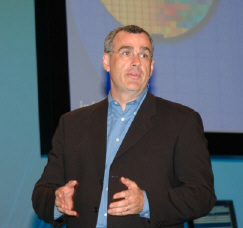Intel plows health care field


As part of the company reorg in January, 'digital' health care was singled out as one of the core platforms, along with enterprise, channel, mobility and digital home. On the digital home front, Intel introduced a second major platform branding effort with VIIV (pronounced "vive") for entertainment systems today. Those platforms are the current markets that Intel wants to cultivate and dominate.
Every other large company that sells technology has to be thinking along the same lines. Louis Burns, the vice president and general manager of the Digital Health Group at Intel, keynoted at the Intel Developer's Forum, giving an impassioned presentation about the need to apply technology to fix the broken health care system. It's an immense problem, and also a great opportunity to do good and make money in Intel's view. "Imagine if each patient had his own standardized health care record that is personal, private and portable," Burns said.
The problem: Out of control spending, inefficiency and needless mistakes that cost lives. Fifteen percent of the U.S. GDP is spent on healthcare and it could rise to 25 percent by 2015, according to Federal Reserve Chairman Alan Greenspan. Today, $6 trillion is spent worldwide on healthcare. Burns also said that by 2050 21 percent of the population will be over 60 years old, an age today when medical cost escalates severely. (Not sure that statistic will mean the same in 2050--60 years old will be like 20 or 30 relative to today's aging process. Forty-five years is a lot of science.)
The vast majority of medical facilities are still paper based, with few systematic controls in place. "There are fewer checks in place in hospitals than buying a book and Amazon.com today," Burns said. His group at Intel is working with the tech and medical industries to develop technology standards. "The real value is from the interaction between all pieces working to improve someone's health," Burns said. "In our first 9 months of research, we found the the single largest healthcare expense was the software written to link various proprietary systems together. The lack of standard interfaces and data could account for up to a third of $6 trillion."
Burns noted that the lack of data and standardization causes about 2 million adverse drug reactions and 100,000 preventable deaths. Electronic ordering has reduced errors by 86 percent, he added, and the 100 most wired hospitals nationwide have an on average risk-adjusted mortality rate that is 7.2 percent lower than other hospitals. (In April, I interviewed John Halamka, CIO of Harvard Medical School, who is one of the leaders in bringing technology into the health care system.) Burns called for a global industry consortium for standards for all healthcare equipment in hospitals and in the home.
Intel is developing reference designs (see above) for devices that interact with medical equipment and that health practitioners, as well as patients, can use. Burns said Intel has been working with doctors and nurses to create the prototypes. The tablet mock ups (see above) have wireless connectivity (Bluetooth, RFID and Wi-Fi) for getting data from instruments, like a stethoscope, and sending data into patient records. One prototype (the one on the right side of the trio pictured above) will allow Parkinson's patients to conduct their own tests. For example, the patient would move plastic pegs from one side of the device to another to test the the state of their tremors. Other capabilities of the device are testing the strength of the patient's voice and downloading a datastream of tremor data from a customized watch. Intel in partnership with medical organizations and top neurologists is beginning investigatory trials with the prototypes in 75 households, said Eric Dishman, general manager of health research and innovation at Intel.
Where's the money to feed Intel's bottom line? "We are trying to grow marketplace," Burns said. "If we can establish standards and a bigger playing field, it will be good for all in the ecosystem. In China, the Chinese People's Liberation Army is specifying 3,000 new hospitals. We are working with them on the architecture and how to deploy, and in the process they will buy products from many of Intel's customers."
If preaching the Intel gospel around the world, pressing for standards and spending R&D on developing new usage models results in improved health care systems faster, then carry on...